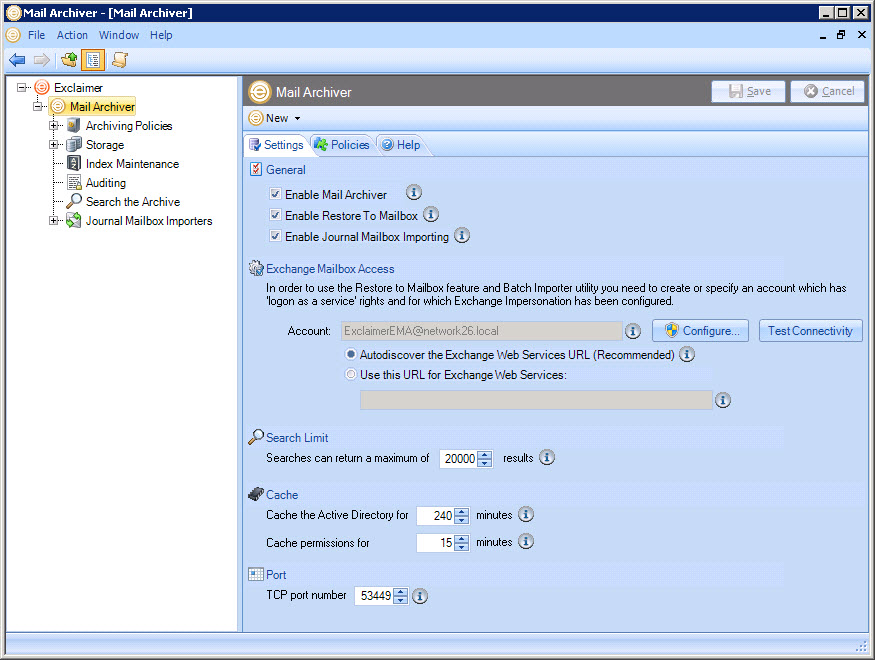

“Strategies for Archiving in Hybrid Environments.Email Archiver version 3 is out. Please use the new site.

In many ways, the native archiving features of Gmail are even more limited.įor compliance, e-discovery, and corporate governance, most companies need a true enterprise-class email archiving solution that augments the platform’s native mailbox archiving features. That leaves out a wide range of employee communication that takes place outside the Microsoft ecosystem, such as social media and instant messaging. And compliance policies can be applied to only a limited set of content. With Office 365’s native archiving features, enterprise-wide email searches are difficult. But without additional services, administrators, auditors, and legal teams can’t adequately archive, search and supervise content across the enterprise.
Mail archiver archive#
With Office 365’s built-in archive, users may be able to easily archive and find old emails. But it’s meant for end-users, not IT departments. It’s a seamless, integrated experience that’s easy to use. With Office 365 built-in archive comes with built-in archiving for end-user mailboxes.
Mail archiver software#
For many organizations with legacy email archiving software and years of data archives to manage, a hybrid approach might make more sense. But the switch can seem daunting, and it comes with its own challenges. For companies already moving their email and collaboration infrastructure to Office 365, the choice is even clearer-even the best on-premises compliance archives can’t archive cloud-based content efficiently.Ĭompared to aging on-premises, cloud based email archiving is often less expensive, easier to manage and more reliable. Retrieving data for audits and legal requests from a cloud-based email archive is usually much easier and faster than with on-premises vaults. The move can also improve security and performance. Such a move can lower costs because cloud services enjoy IT economies of scale that even most large enterprises can’t match. Other companies are moving their archives to cloud based email archiving to shrink their data and infrastructure footprint. The trend will only accelerate as more and more data originates from and lives in the cloud. While email archives have traditionally been stored on magnetic tape and other low-cost media, the cloud is an increasingly popular email archiving option due to falling costs, greater efficiencies, and added capabilities vs. Data centers used to house the cloud archive should be SSAE-16 SOC 2 Type II certified-not just for the physical facilities, but for service itself.
Mail archiver full#
The encryption key should be the organization’s alone-not shared with the cloud archive provider-so that it retains full control over who can access archives data. Consider a cloud archiving solution that protects in transit and at rest in the cloud archive infrastructure. To keep it secure, any data that leaves the environment should be always be encrypted. If the archived data isn’t safe, then organizations run the risk of not being compliant. The solution should also provide full reporting and a transparent, unalterable audit trail that lets the organization demonstrate that it has met all retention, chain-of-custody, and legal-hold requirements. Insist that the cloud archiving vendor can prove that nothing is removed from the journaling mailbox until it is safely in the archive. Consider an email archiving solution that can guarantee that no message is lost, even if the network goes down. To demonstrate the chain of custody and preserve every message organizations need, email archiving best practices dictate that the archive should be failsafe. At the organizational level, it should help IT, compliance and legal teams reduce the cost and complexity managing and monitoring today’s exploding data volumes. And search performance should be fast and accurate no matter how large the archive grows. At the user level, it should be simple and intuitive, with a familiar user experience that fits the organization’s workflow and keeps employees productive. The ideal email archiving system provides a centralized, searchable repository that gives users access to historical data. To get the most of their email archiving investments, organizations should look for these features as part of email archiving best practices: Good performance and user experience Managing an email archiving system in a way that is compliant, cost effective and efficient has never been more complicated. Organizations are generating more data-and more kinds of data-every day.


 0 kommentar(er)
0 kommentar(er)
